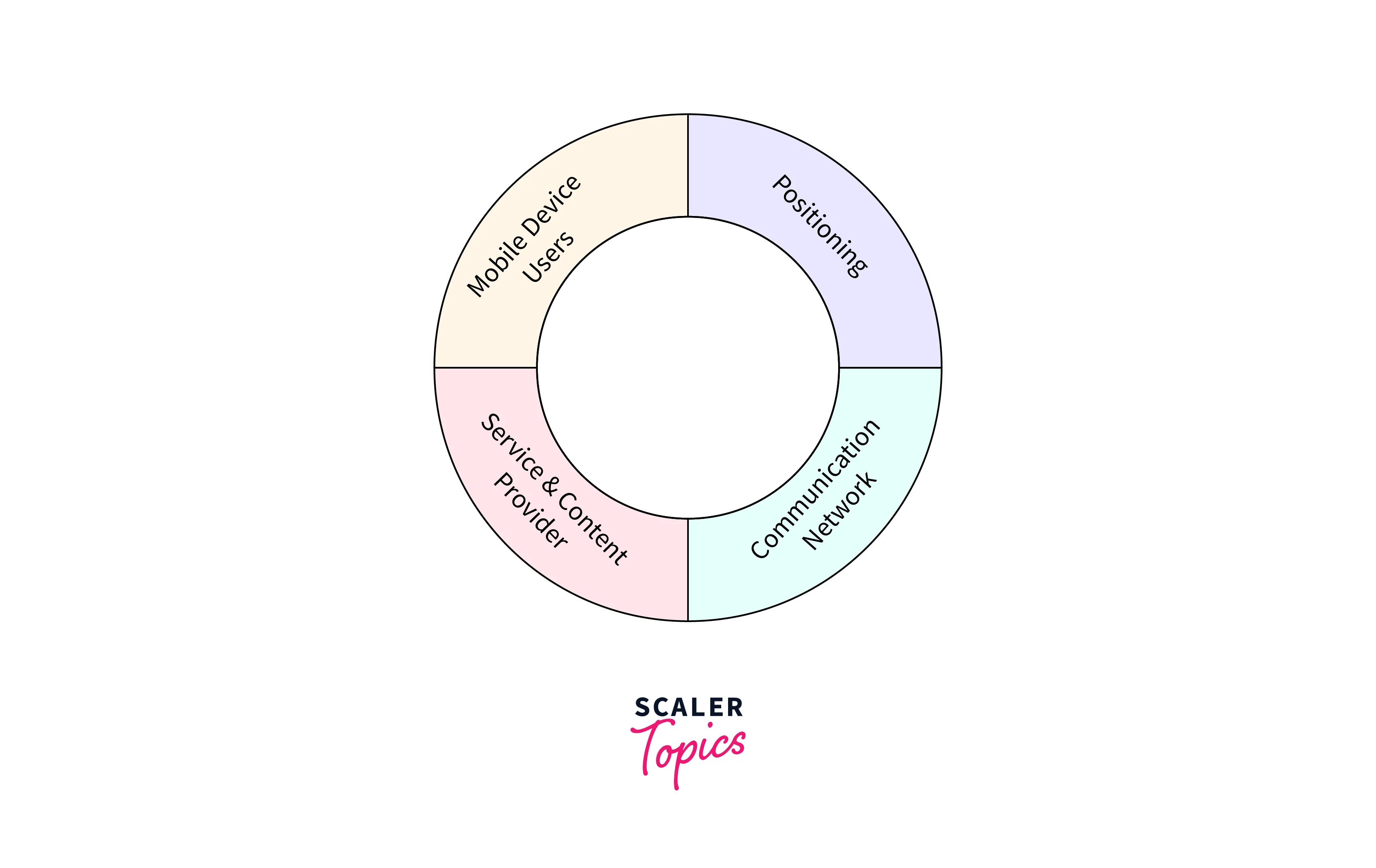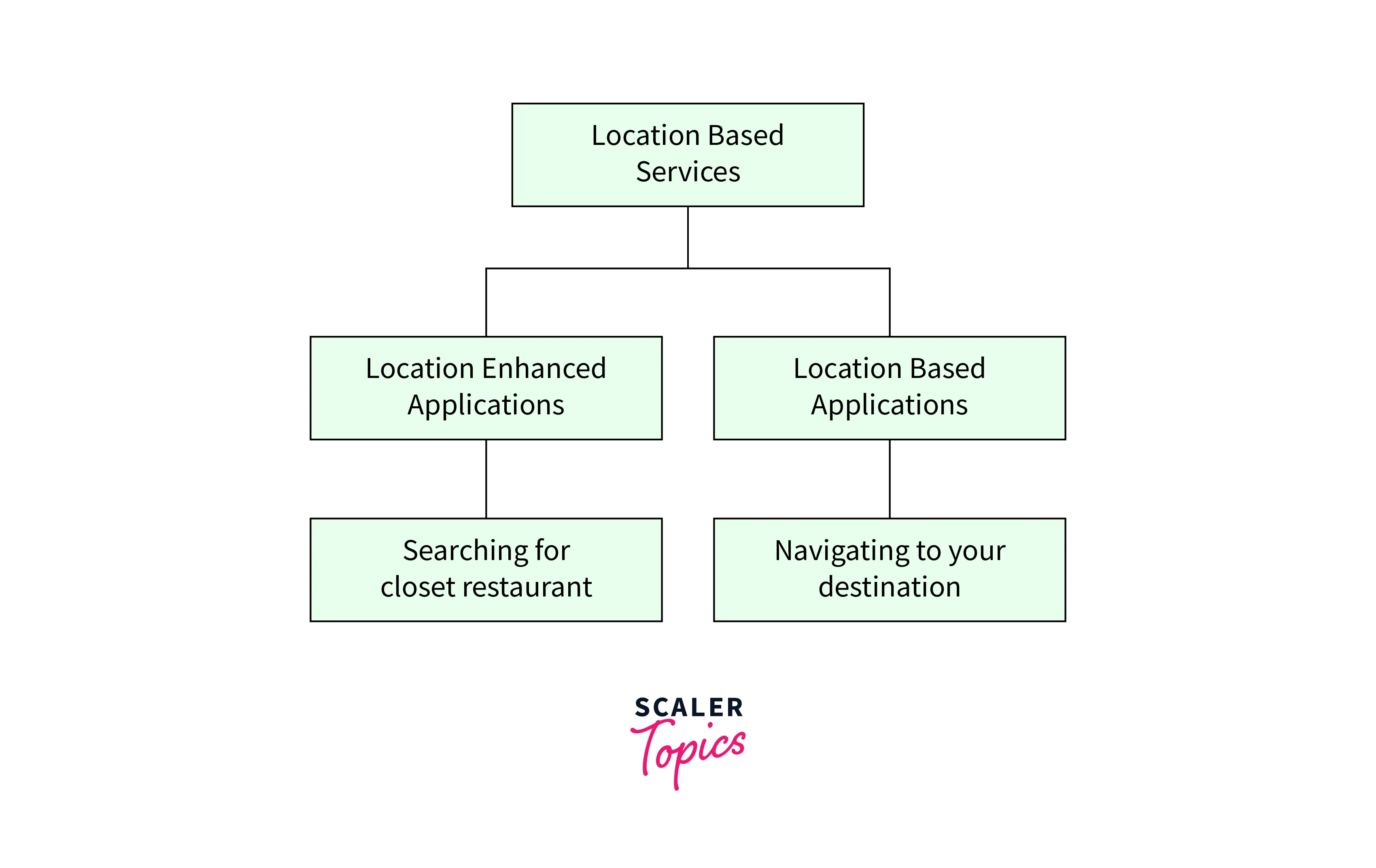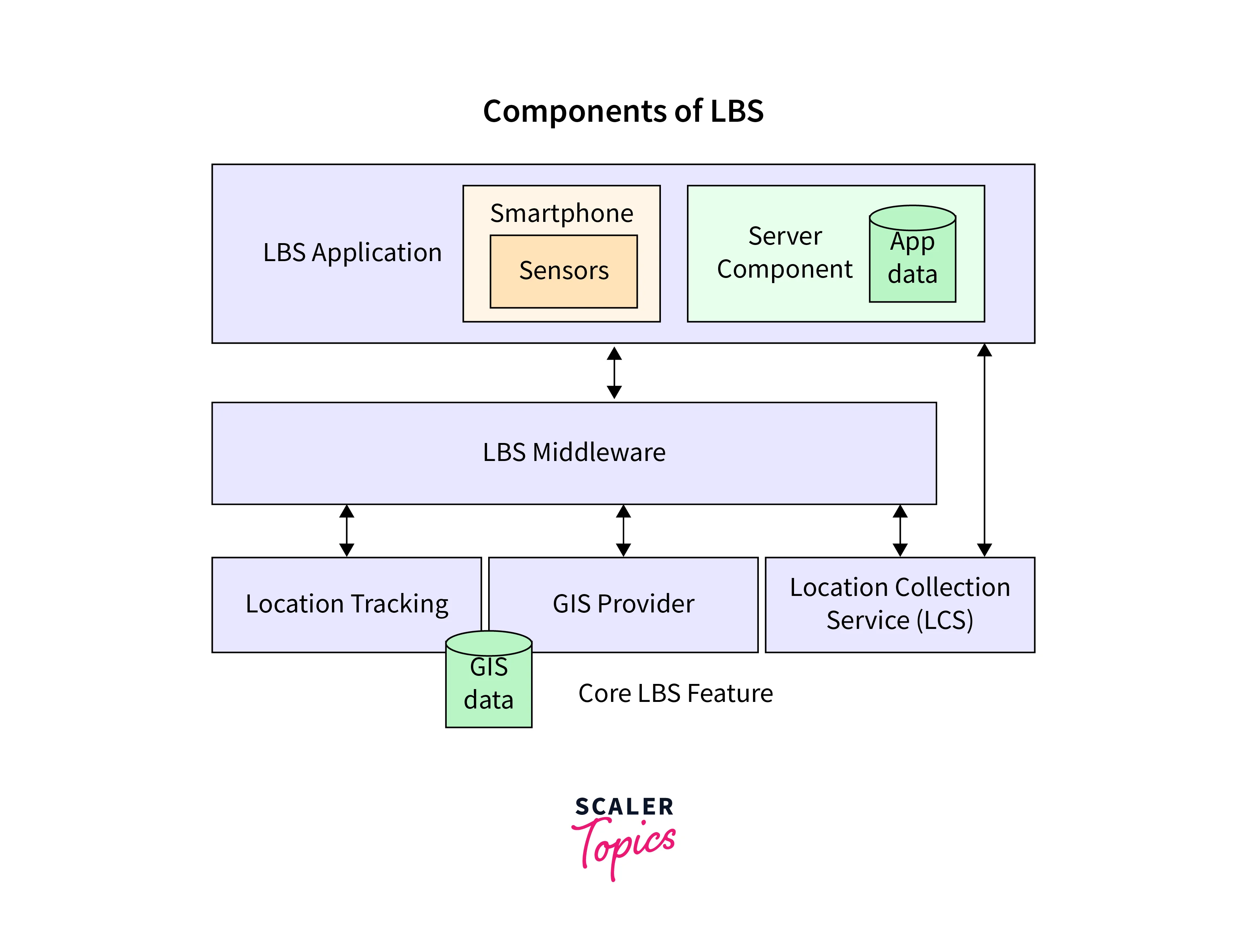Location-Based Services in Android
Overview
Location-Based Services(LBS) in Android provide valuable functionality by leveraging a device's GPS, Wi-Fi, or cellular network to deliver location-specific information and services. These services enable applications to determine the user's current location, track movement and offer personalized experiences. LBS in Android facilitates features such as mapping, navigation, geofencing, location-aware advertisements, and social check-ins. Developers can access location data through the Android Location API, which offers various location providers and methods for obtaining accurate and up-to-date location information. With LBS, Android apps can deliver tailored content and services based on the user's geographic position, enhancing user experiences and enabling location-aware functionality.

What are Android Location-Based Services?

Android Location-Based Services (LBS) refer to the functionalities and capabilities provided by the Android operating system that leverage a device's location data to deliver location-specific information and services. LBS in Android enables developers to create applications that can determine the user's current geographic position, track movement, and offer personalized experiences based on their location.
Geofencing is another significant feature offered by Android's LBS capabilities. Geofencing involves defining virtual boundaries or geofences around specific locations. When a user enters or exits these predefined areas, the app can trigger custom actions or send relevant notifications. Geofencing finds applications in various domains, such as retail, safety, and marketing. For example, an app can send a notification to users when they enter a shopping mall, offering discounts or special promotions for nearby stores.
Social check-ins have become popular features in many Android applications, thanks to LBS. Users can share their current location with friends or publicly announce their presence at a specific venue. This functionality allows for social interactions, recommendations, and the discovery of nearby places based on the experiences of others. Apps like Foursquare and Facebook have successfully incorporated social check-ins into their platforms, enabling users to share their whereabouts and discover new places.
Components of Location-Based Services in Android

Location-Based Services (LBS) in Android rely on several key components to provide accurate and up-to-date location information. These components include the LocationManager class, the LocationListener interface, the LocationProvider, and the Location class. Let's explore each of these components in detail.
LocationManager Class
The LocationManager class in Android is a central component responsible for interacting with the system's location services and managing location updates. It acts as a bridge between the application and the underlying hardware and services that provide location information. Developers use the LocationManager class to request location updates, retrieve the last known location, and manage location providers. To obtain an instance of the LocationManager class, developers can use the getSystemService() method, passing the LOCATION_SERVICE constant. This allows the application to access the system's location services and perform location-related operations.
LocationListener Interface
The LocationListener interface is used to receive location updates from the LocationManager class. Developers implement this interface and override its methods to handle location updates and respond to changes in the user's position. The LocationListener interface defines three methods:
- onLocationChanged(): This method is called when a new location update is available. Developers can retrieve the updated location from the Location parameter passed to this method and perform any necessary actions based on the new location data. For example, an application might update a map with the user's current location or trigger location-based notifications.
- onStatusChanged(): This method is invoked when the status of the location provider changes. It provides information about the availability, enabling, or disabling of a location provider. Developers can use this method to handle changes in the availability of location providers and adapt their application's behavior accordingly. For example, if the GPS provider becomes temporarily unavailable, the application might switch to using network-based location updates.
- onProviderEnabled() and onProviderDisabled(): These methods are called when a location provider is enabled or disabled, respectively. Developers can use these methods to handle changes in the availability of location providers and inform the user about the status of location services. For example, an application might display a message when GPS is disabled, prompting the user to enable it for better location accuracy.
LocationProvider
A LocationProvider represents a source of location data, such as GPS, network-based location, or other custom location sources.
Android provides several built-in location providers:
- GPS_PROVIDER: Uses the device's Global Positioning System (GPS) to provide accurate location information. It offers high accuracy but may consume more power and require a clear line of sight to GPS satellites.
- NETWORK_PROVIDER: Utilizes Wi-Fi and cellular network signals to determine the user's location. It offers location updates with lower power consumption but may be less accurate than GPS. Network-based location can be particularly useful in urban areas with dense Wi-Fi networks.
- PASSIVE_PROVIDER: Allows the application to receive location updates passively, without directly requesting them. This provider listens for location updates generated by other applications or services. It is useful when an application needs location updates but does not require controlling the frequency or source of those updates.
Location Class
The Location class in Android represents a geographic location. It encapsulates the latitude, longitude, altitude, and other optional information, such as speed and bearing, associated with a particular location. Developers can obtain a Location object either from location updates received via the LocationListener interface or by querying the LocationManager for the last known location using the getLastKnownLocation() method. The Location class provides methods to access and manipulate location data, such as getting latitude and longitude coordinates, calculating the distance between locations, and retrieving additional information like altitude and speed.
Location Object
The Location object in Android is a key component of Location-Based Services (LBS) that represents a geographic location. It encapsulates information such as latitude, longitude, altitude, and other optional attributes associated with a particular location. The Location object provides methods and properties to access and manipulate location data, making it an essential class for handling location-related functionality in Android applications.
Location Quality of Service
Location Quality of Service (QoS) is a crucial aspect of Location-Based Services (LBS) in Android. It refers to the level of accuracy, reliability, and availability of location information provided to applications. Developers need to consider QoS factors when designing location-aware applications to ensure a satisfactory user experience and effective functionality. Android offers various mechanisms and parameters to assess and manage the quality of location services.
-
Accuracy: Accuracy is a fundamental aspect of location services. It refers to the degree of closeness between the reported location and the user's actual position. Android provides a measure of accuracy through the Location object's getAccuracy() method. Accuracy is typically represented as a radius within which the actual location is likely to exist. Smaller accuracy values indicate higher precision, while larger values indicate a broader range of possible locations. Developers can utilize this information to make decisions based on the reliability of the location fix and ensure accurate positioning in their applications. For example, applications requiring precise navigation or proximity-based functionality may need higher accuracy levels.
-
Power Consumption: Location services, particularly those that rely on GPS, can consume significant amounts of power. To balance accuracy and power efficiency, Android offers different location providers with varying power consumption profiles. Developers can choose between GPS_PROVIDER, NETWORK_PROVIDER, and PASSIVE_PROVIDER based on their application's requirements. GPS_PROVIDER provides high accuracy but consumes more power, while NETWORK_PROVIDER utilizes Wi-Fi and cellular signals with lower power consumption but potentially lower accuracy. The choice of location provider can significantly impact the battery life of the device and should be considered when designing location-based functionality. Developers should strike a balance between accuracy and power consumption to ensure an optimal user experience.
-
Availability: Location services may not always be available due to various factors such as device hardware limitations, user settings, or environmental conditions. For example, indoor environments or areas with poor GPS reception may result in limited availability of GPS-based location updates. Android provides mechanisms to determine the availability of location providers. The LocationManager class offers methods such as isProviderEnabled() to check if a specific provider is enabled on the device. By considering the availability of location services, developers can provide appropriate fallback mechanisms or user notifications when location services are not accessible. For example, an application might switch to network-based location updates if GPS is unavailable or prompt the user to enable location services if they are disabled.
-
Time-to-First-Fix: Time-to-First-Fix (TTFF) refers to the duration it takes for a location provider to acquire the first location fix after being enabled. This is particularly relevant for GPS-based location providers, as they need time to establish a connection with satellites and obtain accurate position information. Android provides the getElapsedRealtimeNanos() method in the Location object, which can be used to measure the time it takes to acquire the first fix. Developers can monitor the TTFF and manage user expectations accordingly, such as displaying loading indicators or progress bars during the acquisition process. Users may experience delays in receiving accurate location updates, especially when using GPS, and being transparent about the acquisition process can enhance the user experience.
-
Location Update Frequency: The frequency at which location updates are received can impact the user experience and power consumption. Android allows developers to specify the time interval and distance threshold for location updates through the LocationManager class. By selecting appropriate values for these parameters, developers can balance the need for real-time location updates with power efficiency. For example, an application that requires frequent location updates for real-time tracking may opt for shorter intervals, while an application focused on periodic updates for less time-sensitive information may choose longer intervals to conserve power. Adjusting the update frequency based on the application's requirements can optimize the user experience and power consumption.
Geocoders
Geocoders in Android are essential components of Location-Based Services (LBS) that facilitate the conversion of textual addresses or place names into geographic coordinates (latitude and longitude) and vice versa. Android provides the Geocoder class as an API to perform geocoding and reverse geocoding operations, enabling developers to incorporate geospatial functionality into their applications.
When working with Geocoders in Android, developers should handle geocoding results effectively. Multiple Address objects can be returned for a single geocoding or reverse geocoding query. Developers should consider the possibility of multiple matches and determine the most relevant or accurate address based on their application's requirements. It's important to handle potential errors or empty result sets appropriately and inform users accordingly. Geocoding results may vary in accuracy and availability, depending on factors such as the underlying mapping service and the quality of the input.
Implementation of Location-Based Services in Android
Implementing Location-Based Services (LBS) in Android involves leveraging the platform's built-in location APIs and integrating them into your application. Here are the key steps to implement LBS in Android:
-
Request Location Permissions: First, ensure that your application has the necessary permissions to access the device's location. In the AndroidManifest.xml file, add the required permissions such as ACCESS_FINE_LOCATION or ACCESS_COARSE_LOCATION. Additionally, starting from Android 10 (API level 29), you may need to request runtime permissions from the user explicitly.
-
Use the LocationManager Class: The LocationManager class is the central component for accessing location services in Android. Obtain an instance of the LocationManager using getSystemService() and the LOCATION_SERVICE constant.
-
Select Location Provider: Choose the appropriate location provider based on your application's requirements. Android provides different location providers such as GPS_PROVIDER, NETWORK_PROVIDER, and PASSIVE_PROVIDER. GPS_PROVIDER offers high accuracy but consumes more power, while NETWORK_PROVIDER utilizes Wi-Fi and cellular signals with lower power consumption but potentially lower accuracy. Select the provider that suits your needs.
-
Register a LocationListener: Implement the LocationListener interface and register it with the LocationManager using the requestLocationUpdates() method. This enables your application to receive periodic location updates. Implement the necessary callback methods, such as onLocationChanged(), to handle location updates and process the received location data.
-
Handle Location Updates: In the onLocationChanged() method, extract the location data from the Location object provided as a parameter. You can access latitude, longitude, altitude, speed, and other location attributes. Process this data according to your application's requirements, such as updating a map, triggering notifications, or calculating distances.
-
Geocoding and Reverse Geocoding: To convert textual addresses or place names into geographic coordinates (geocoding) or vice versa (reverse geocoding), use the Geocoder class. Instantiate a Geocoder object and call methods like getFromLocationName() or getFromLocation() to retrieve Address objects representing location information.
-
Handle Errors and Edge Cases: Consider potential errors and edge cases in location services. For example, handle scenarios where location services are disabled or unavailable, where permissions are not granted, or where no location data is available. Provide appropriate error messages or fallback mechanisms to ensure a smooth user experience.
-
Optimize Power Consumption: To optimize power consumption, consider factors like location update frequency and location provider selection. Determine the appropriate update interval based on your application's needs and the desired balance between real-time updates and power efficiency. Use lower power-consuming location providers, such as NETWORK_PROVIDER, when high accuracy is not crucial.
-
Enhance User Experience: Leverage location data to enhance the user experience. For example, integrate maps to display the user's location, provide directions, or highlight nearby points of interest. Implement geofencing to trigger specific actions when the user enters or exits predefined geographical areas. Utilise location-based advertising or personalised recommendations based on the user's current location.
Conclusion
- Location-Based Services (LBS) in Android provide functionalities to leverage location information and enhance applications with geospatial capabilities.
- Android offers a range of location APIs and classes, including the LocationManager, LocationListener, Geocoder, and LocationProvider, to implement LBS functionality.
- Request appropriate location permissions in the AndroidManifest.xml file, such as ACCESS_FINE_LOCATION or ACCESS_COARSE_LOCATION, to access the device's location.
- Choose the appropriate location provider based on the application's needs, such as GPS_PROVIDER, NETWORK_PROVIDER, or PASSIVE_PROVIDER, considering accuracy and power consumption requirements.
- Implement necessary callback methods, like onLocationChanged(), to handle location updates process the received location data and utilise the Geocoder class for geocoding (converting textual addresses to geographic coordinates) and reverse geocoding (converting coordinates to addresses).
- Optimize power consumption by selecting appropriate location providers and determining the update frequency based on application requirements.
- Enhance the user experience by integrating maps, implementing geofencing, or providing location-based recommendations and advertisements.
